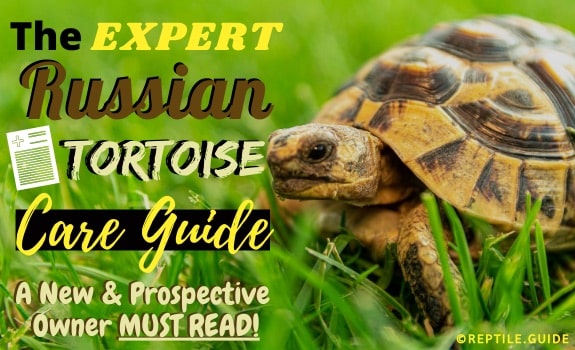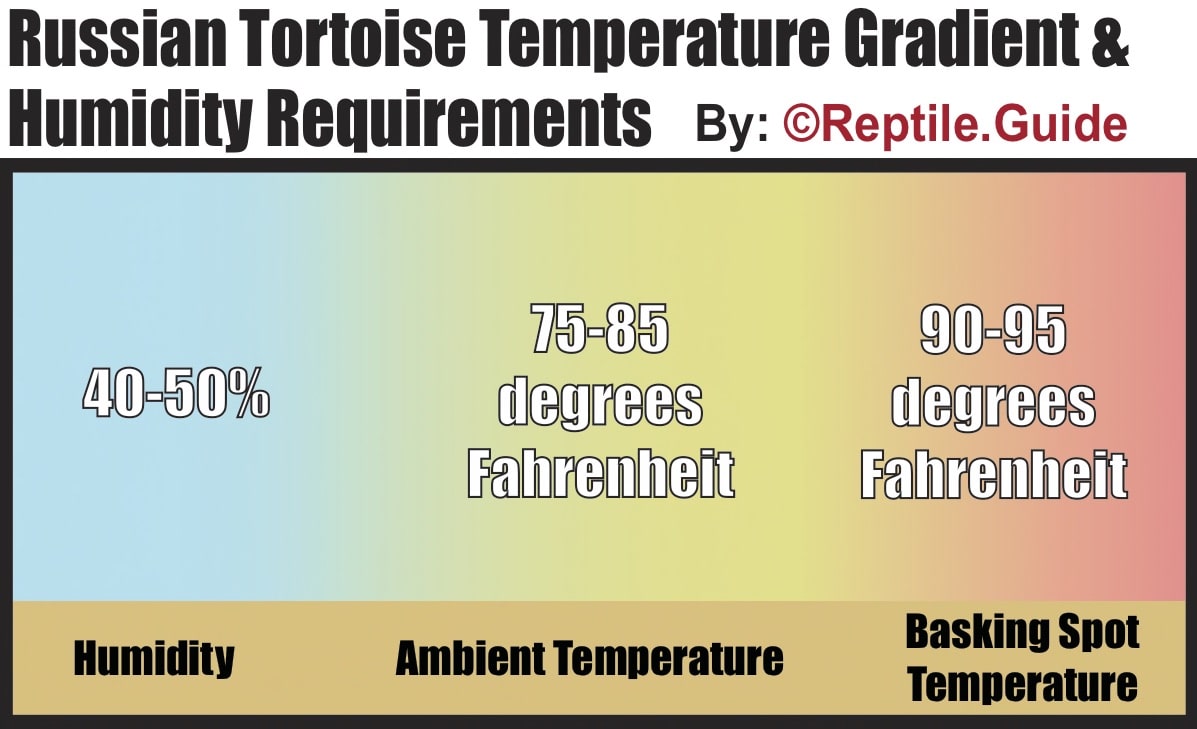An adorable tiny tortoise, the Russian tortoise (opens in new tab) makes an excellent pet for first-time exotic pet owners and well-seasoned pros alike.
These small tortoises may only grow to reach 5 to 10 inches in length, making them much easier to care for than the giant Aldabra tortoise, which can weigh in at 550 pounds!
What You’ll Learn In This Russian Tortoise Care Sheet:
- Background information on Russian tortoises
- Where to buy a healthy Russian tortoise
- Relative cost of a Russian tortoise
- Proper diet for all ages
- How to properly set up a Russian tortoise enclosure
- Health concerns to be aware of (plus how to prevent them!)
- Handling & bonding tips
- & So much more!
A forgiving reptile, Russian tortoises simply retreat to their burrows to avoid inhospitable climates, waiting until the ideal temperature is reached before emerging.
As such, if you don’t see your tortoise for an extended period, there’s a good chance the enclosure’s temperature needs adjusted.
If you’re interested in adding an adorable, pocket-sized tortoise to your family, brush up on your Russian tortoise knowledge first to ensure you create the proper habitat for your new friend.
Or, if you want to discover novel diet options for your creep of tortoises, this in-depth Russian Tortoise Care sheet has plenty of tasty veggies to add to your pet’s diet.
Read on to discover everything you need to know to provide top-notch care for your Russian tortoise.
In This Article
Russian Tortoise Background Information
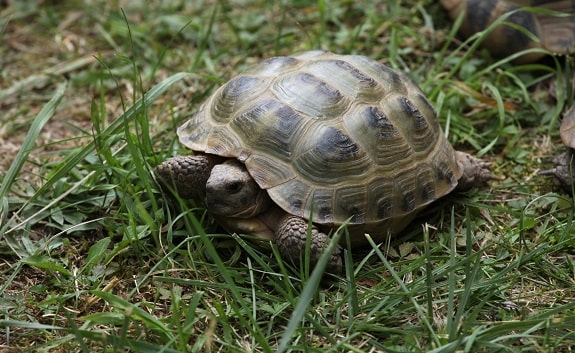
Russian tortoises are common pet reptiles native to Central Asia, particularly Russia, China, Pakistan, and Iran.
Though numerous as pets and breeders around the world, Russian tortoises are actually nearing extinction in their native habitat. Despite being such a common pet, they have not become an invasive species outside their native homeland, likely due to their specific habitat needs, which are difficult to find elsewhere.
Besides the moniker “Russian tortoise,” they have a number of other common names, including Afghan tortoise, steppe tortoise, Horsfield’s tortoise, and Central Asian tortoise.
Thriving in barren, arid environments with low rainfall, Russian tortoises are commonly found in steppes, deserts, hillsides, and grasslands.
In these harsh, arid environments, the weather can range from one extreme to the other, forcing the tortoises to retreat to their burrows for months at a time.
These tiny tortoises measure in at a length of 5 to 10 inches, with the females of the species reaching the larger side of the range. This larger size allows the female to hold a batch of eggs inside her body; each clutch will consist of up to five eggs.
With proper care, these small reptiles can live up to 40 years, making them a long-term, but delightful, commitment.
The shell of a Russian tortoise is usually a ruddy brown or black color, which lightens to yellow in between the scutes. The body is a straw-yellow or brown color, depending on the subspecies.
Another identifiable feature of the Russian tortoise is that it has four claws on each foot that are used for climbing and digging. This is a feature not always seen in other tortoises, so it’s a great method of distinguishing this species from others.
Armed with the knowledge that a Russian tortoise makes an ideal pet for a beginner or a lifelong reptile lover, be sure to set aside some cash BEFORE rushing into a tortoise purchase.
These tiny tortoises can range from $75 to $200, depending on size, age, and sex. Additionally, creating the perfect enclosure may cost another $200 or more.
Fortunately, food costs are relatively minimal. Also, if you are able to chose a healthy tortoise as a pet, veterinary costs should be under $100 for a new pet check-up and necessary deworming or care.
All in all, look at spending roughly $500 on your new pet and habitat set-up.
Once you’ve got money saved for your charming new tortoise? Well, it’s time to go shopping (see next section)!
🔑 Russian Tortoise Background Key Takeaways: Russian tortoises are native to the arid environments in Central Asia and grow to be 5-1o inches long, with females tending to be larger than males. When it comes to lifespan, a well cared for Russian tortoise can live up to 40 years! When shopping for a Russian tortoise, expect to spend around $500 at least on your tortoise and their tank setup.
Where to Buy a Russian Tortoise
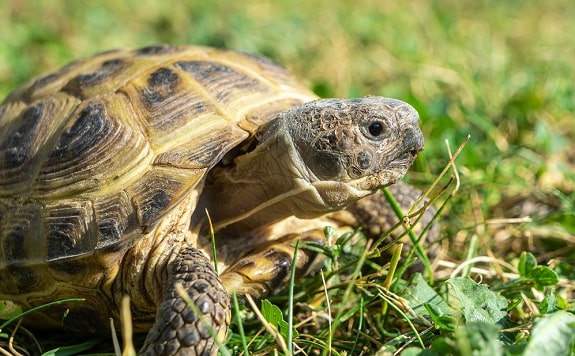
The MOST common place to buy a Russian tortoise is at a pet shop; however, it may not be your best choice.
When searching for a pet shop, don’t choose one simply because they carry Russian tortoises! First, look around the entire store, taking a good whiff when you walk in the door.
Does it smell and look clean?
Next, make a quick stop at the fish tanks. Do the fish appear healthy, or are dead fish floating in the tanks?
Peruse the exotic pet section, checking for cleanliness and the apparent health of the animals. Discuss the care and husbandry required of Russian tortoises with the pet store staff.
While many pet stores, especially chain stores, are NOT the most knowledgeable about the creatures in their care, small, family-owned pet stores can be a wonderful resource for information and pet supplies in the future. These types of pet stores are the best sort from which to purchase your new tortoise.
Another popular option for purchasing tortoises are reptile expos. Many large cities have monthly shows with a wide variety of vendors selling live animals and supplies. Unfortunately, you may run into the same issue here that you might as pet stores…
Some vendors CLEARLY know their stuff, while others have little knowledge about their pets or supplies.
Another drawback to reptile expos are the close housing quarters with other species, which can lead to cross-contamination or health problems.
If you’re a first-time tortoise owner, a reptile expo may not be the best place to purchase your new pet. However, it can be a wonderful way to check out different breeders and see reptiles in person before making an online purchase.
Some of the most knowledgeable breeders can be found online. Many of these reputable breeders will even offer a health guarantee when purchasing one of their animals.
The only downside to purchasing a tortoise online is that you cannot see the animal in person first.
How to Choose a Healthy Russian Tortoise
When picking out your new pet, keep a few factors in mind to ensure you purchase a healthy animal.
Check the following criteria when inspecting your potential new tortoise:
- Is the tortoise active?
- Does the tortoise feel like an empty shell when held?
- Do you hear any raspy or gurgling sounds when listening to the tortoise breathe?
- Is the shell relatively smooth or lumpy?
- Does the shell have any white spots, soft areas, or spots with a foul odor?
- Are the eyes a shiny, clear black? Or, are they dull, sunken, or full of mucus?
- Is the nose dry and clean, or are there bubbles or a mucus plug?
- Are the toenails overgrown?
- Is the tail clean and dry, or caked with feces?
If you’re at all unsure about the health of a potential new pet, avoid jumping into an impulse purchase and wait to find a healthy animal instead.
🔑 Russian Tortoise Purchasing Key Takeaways: When looking to purchase a Russian tortoise, you’ll essentially have 3 options: Chain pet store, private breeder, pet expo, or mom and pop pet shop. Don’t be afraid to be highly critical of chains and expos alike. Ideally, you’d find a private breeder as they tend to raise the healthiest tortoises. When picking a tortoise out, be sure to examine its shell, breathing, face, toenails, tail, and activity level to BEST gage its overall health.
Russian Tortoise Diet and Feeding Guidelines
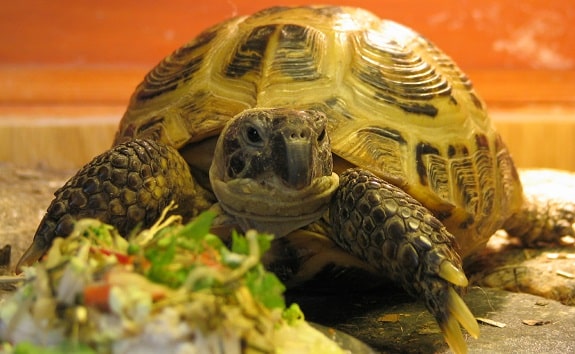
The Russian tortoise is a grazing animal, and they display these natural behaviors by eating large amounts of weeds, leaves, and flowers before returning to hibernation.
This tortoise hibernates in the cold months and it may also aestivate because it is uncomfortable in high temperatures.
The term aestivation refers to a semi-conscious sleeping period during the summer, while the term hibernation refers to a semi-conscious sleeping period during the winter.
What Do Russian Tortoises Eat?
As grazers, Russian tortoises enjoy broad-leaf plants, and dandelion is a favorite. When purchasing foods at the grocery store, all foods should ideally be organic and pesticide-free.
Your tortoise may delight in munching on the following fresh foods:
- Romaine lettuce (fed on occasion)
- Red and green leaf lettuce (fed on occasion)
- Endive
- Escarole
- Radicchio
- Chicory
- Turnip greens
- Mustard greens
- Kale
- Collards
- Spring Mix (mixed salad greens)
- Cabbage (fed on occasion)
Using several vegetables is IDEAL in a Russian tortoise diet to provide as many vitamins and nutrients as possible.
Form the basis of your pet’s diet with the above greens, and supplement it with the following flowers:
- Hibiscus
- Hosta
- Sedum
- Mulberry leaves
- Hen and Chicks
- Ice Plants
- Prickly pear flowers, fruit and pads
- Dandelion
- Mallow
- Henbit
- Rose
- Chrysanthemum flowers
- Cornflowers
- Forsythia
If your tortoise lives indoors, consider growing your own leafy greens. This ensures you’ll have a fresh supply of pesticide-free food for your tortoise.
Avoid feeding your tortoise meat, grains, and nutrient-deficient foods, such as iceberg lettuce. Fruit is another item to leave off your tortoise’s menu, as consumption of fruit can cause parasite blooms.
Russian Tortoise Supplements
For tortoises who do not have continued exposure to the sun, be sure to dust the food daily with a calcium supplement.
When it comes to a multi-vitamin supplement, you’ll want to use one that contains vitamin D3. This should be sprinkled on the food once or twice weekly.
Russian Tortoise Water Needs
Being an arid species, much of a Russian tortoise’s water can be extracted from their food. However, they still require a large, shallow pan of water.
They often use bodies of water to keep their eyes and nose clean, and to regulate body temperature.
To satisfy the needs of your tortoise, provide a shallow pan that’s large enough to fit your pet comfortably. A good rule of thumb to follow when filling your tortoise’s water dish is that the water shouldn’t be any higher than the point where the carapace and plastron meet.
Tortoises generally defecate and urinate while soaking in their tub, so change the water frequently to keep it clean.
Adults typically require a good soak once per week, while hatchlings need a daily soak.
How Often to Feed Your Russian Tortoise
When feeding your tortoise, offer as much food as your pet can eat in 20 minutes ONCE per day. Remove any uneaten food after the 20-minute mark to avoid spoilage.
Outdoors, they can graze free-range and be fed small amounts of supplemental food daily. Fresh hay is an EXCELLENT grazing option, especially if your enclosure does not contain much in the way of weeds or flowers.
Timothy, orchard, and Bermuda hays work well for Russian tortoises.
🔑 Russian Tortoise Diet & Feeding Key Takeaways: When it comes to a well balanced diet, Russian tortoises do best with a variety of different greens, as well as a calcium supplement and multi-vitamin. They also require a large, shallow water dish. You’ll need to feed you adult and baby tortoise once a day, offer them as much as they can eat within 20 minutes.
Russian Tortoise Habitat and Tank Setup
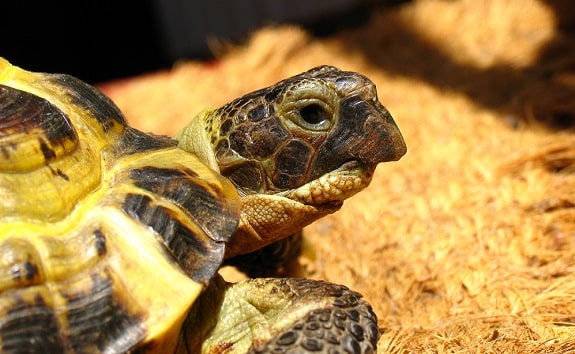
Size of the Enclosure
Provide tortoises with the LARGEST habitat that space allows, since free-ranging tortoises in their natural habitat utilize ranges measured by square miles.
Regardless of whether they’re indoors or outside, pens should measure at least 12 square feet. You’ll also want to increase pen size to accommodate each additional tortoise.
If you have your heart set on owning a Russia n tortoise but simply don’t have the space, you may want to consider adopting a Red-Eared Slider instead. Red-Eared Sliders, while turtles and NOT tortoises, are great, hardy pet turtles.
Type of Enclosures
Depending on your average temperature, your Russian tortoise will do well in an outdoor enclosure. This can be landscaped with edible plants, while the outdoor environment also allows your tortoise to bask in the sun if it is not too hot.
Outdoor pens are the best option to keep your pet happy and healthy, providing the temperatures don’t dip much below 25 degrees Fahrenheit and insulated hide spots are offered. Tortoises also aestivate and need a space where they can retreat from the heat of a summer’s day.
The most common types of enclosures pet owners choose for their reptiles include:
Aquariums
Aquariums are often recommended by pet shop employees, since they generally don’t have the best knowledge about Russian tortoises. Unfortunately, these glass enclosures are unsuitable for tortoises because the air circulation is so poor, leading to inadequate ventilation caused by the aquarium’s shape.
Besides poor ventilation, the clear glass sides are also stressful to tortoises. They will continually try to escape through the glass and potentially cause injury to themselves.
If you MUST use an aquarium to house your tortoise, it must be a minimum of 75 gallons AND outfitted with a circulating fan and visual barrier.
Rubbermaid Storage Containers
An inexpensive indoor option, Rubbermaid storage containers are an ideal alternative to glass aquariums. The 50-gallon container is a great starting point for one tortoise, plus it’s light and easy to clean.
An added benefit for your tortoise is that the sides are blessedly opaque, so your pet will not come to harm by attempting to escape.
Outdoor Pens
Outdoor pens are by far the BEST option for a happy, healthy, thriving Russian tortoise. They get the benefit of sunshine, which is vital for the synthesis of vitamin D3, plus they get more exercise in larger outdoor pens.
A pen can also be sown with a variety of plants, flowers, and leafy greens, providing edible landscaping.
While designing your tortoise’s outdoor pen, keep in mind these creatures are incredibly active and are master escape artists. They will try to sneak out of their enclosure by climbing or digging, so the pen must be high enough to defeat their climbing skills, plus have a fence that has been dug into the ground at least 8 to 12 inches deep.
If the tortoise can see something of interest on the other side, they will try to dig out. For extra security, place some large rocks along the edges of the fence.
Be sure to keep your tortoise safe from predators as well. Consider using a secure, screened cover to keep out dogs, foxes, raccoons, and birds.
No matter what sort of enclosure you choose for your Russian tortoise, ensure it is large enough to provide room to exercise, plus guarantee it is escape-proof.
Ideal Temperature Gradient
When it comes to the correct temperature, an indoor tortoise enclosure should be fitted with a basking area in which the temperature is approximately 90 to 95 degrees. Fahrenheit.
The ambient temperature can range from 75 to 85 degrees during the day, while nighttime temperatures can drop to 60 degrees.
However, if the temperature drops too much, your tortoise will NOT be able to digest food. If your outdoor climate cannot maintain an ideal temperature year-round, you will also have to use an indoor enclosure for your pet.
If this proves to be necessary, stick to providing the same temperatures to allow for a toasty basking area and a cooler side to aid in thermoregulation.
Ceramic heat emitters and under-tank heaters may be used as primary sources of heat for indoor enclosures.
Lighting Requirements
A Russian tortoise will thrive in an environment which has 12 hours of light and an equivalent 12 hours of dark. These equivalent periods of light and dark will keep the tortoise in peak condition, whereas too much light and heat may cause aestivation.
A full-spectrum lighting system with UVB rays is a NECESSITY, so pick up UVB light bulbs when purchasing standard lighting.
Tortoises need exposure to UVB rays for about 10 hours per day to remain healthy. If your tortoise is kept exclusively outdoors, there is no need for any additional lighting setup.
Ideal Humidity Levels
Humidity levels for Russian tortoises must be kept relatively low. An ideal humidity level runs between 40% and 50% to keep your tortoise in tip-top shape.
Whether your tortoise is in an indoor habitat or an outdoor enclosure, keep a close eye on humidity levels with the aid of a hygrometer. Incorrect humidity levels can lead to a variety of health issues.
Substrate
To promote digging and burrowing, use a loose substrate in your Russian tortoise’s enclosure. The IDEAL substrate is considered to be a mix of sand and garden loam.
However, if you would prefer not to use the above mixture, you can also use:
- Cypress mulch
- Coconut fiber
- Peat moss
- Shredded paper
The substrate should be deep enough for your tortoise to burrow, so this depth can range from 10 inches to 3 feet.
Decor and Accessories
Russian tortoises do best in outdoor environments with plenty of grasses and plants for grazing, such as Bermuda, rye, and fescue grass.
Other plants are also a GREAT addition to your tortoise’s pen. They provide some enrichment while also creating shade.
Some excellent choices for additional plants in your tortoises’s enclosure include:
- Prickly pears
- Bristle brushes
- Desert sage
- Large palo verde trees
If you can’t find these plants, or they don’t grow well in your area, any non-toxic native plants will do.
Hide boxes made of wood are ALSO necessary for keeping your tortoise happy and healthy. Offer several hide boxes, pointing in different directions in your outdoor tortoise enclosure. Various directions allow your pet to either seek solace from the sun or conserve warmth as needed.
To keep your tortoise entertained in the pen, add some flat rocks. Although you wouldn’t think so, Russian tortoises are skilled climbers and enjoy rambling over rock formations.
🔑 Russian Tortoise Habitat & Tank Setup Key Takeaways: When it comes to enclosure size, bigger IS always better. But if you’re short on space, aim to offer at minimum a pen that measures 12 square feet. Always offer multiple hide boxes, use a loose substrate, and ensure your tortoise has access to 10 hours of UVB. Aim for a basking spot in the low 90s degrees Fahrenheit, with ambient temps around 80 and a humidity level no higher than 50%. Your tortoise can be housed outdoors year long unless the lows get below 60 degrees, in which case they should be brought inside.
Russian Tortoise General Health Information
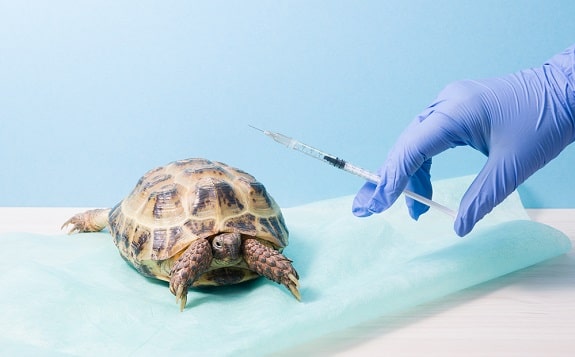
Hibernation
The Russian tortoise both hibernates and aestivate. The hibernation period is during cold months, while a tortoise may aestivate if it’s too hot or if there is a lack of food or water.
A pet tortoise may not experience the same cues of temperature that motivate it to hibernate, especially if kept indoors.
If a pet tortoise does NOT appear to be in good health, then it is better not to encourage hibernation. This is because poor health may not permit survival through the winter.
A healthy tortoise may automatically slow down eating when it is ready to hibernate. Aestivation may not be necessary for pet tortoises, unless a heat wave has driven up the temperatures.
In the wild, Russian tortoises hibernate up to NINE months of the year. In captivity, they appear to benefit from as little as eight weeks in hibernation.
Discuss your tortoise’s personal needs for hibernation and aestivation with your veterinarian, since they can help you determine if your pet is healthy enough for hibernation OR if you need to make adjustments to the habitat or diet.
Pyramidal Growth
Pyramidal growth occurs when the scutes of a tortoise grow vertically instead of growing horizontally during size increases.
This condition commonly happens when a tortoise…
- Receives too much protein
- Is overfed
- Has low enclosure humidity levels
- Receives inadequate hydration
- Has a calcium deficiency
Respiratory Infections
Commonly appearing when the humidity level is too high, respiratory infections in Russian tortoises can create excessive mucoid discharge from the nose or mouth.
You may also notice your tortoise wheezing or struggling to breathe if the infection becomes severe.
If your tortoise develops a respiratory infection, they will generally need antibiotics and supportive nursing care until they recover.
Metabolic Bone Disease
As with many other reptiles in captivity, metabolic bone disease is a serious issue. Caused by a calcium deficiency, your tortoise may experience a weak and brittle shell, along with skeletal issues.
Provide plenty of calcium-rich dark, leafy greens, supplement with a calcium powder, and offer a UVB light source to help provide vitamin D3, which is necessary for calcium metabolism.
🔑 Russian Tortoise General Healthy Key Takeaways: Although generally hardy and healthy individuals, Russian tortoises do suffer from their fair share of health concerns. While minor health concerns such as long toe nails and minor scratches are to expected, you should be well ware of some of the more serious conditions, including Respiratory Infections, Metabolic Bone Disease, and Pyramidal Growths. By maintaining a healthy and varied diet with proper calcium, as well the right humidity levels, you can help prevent most of these issues.
Russian Tortoise Handling & Bonding Tips
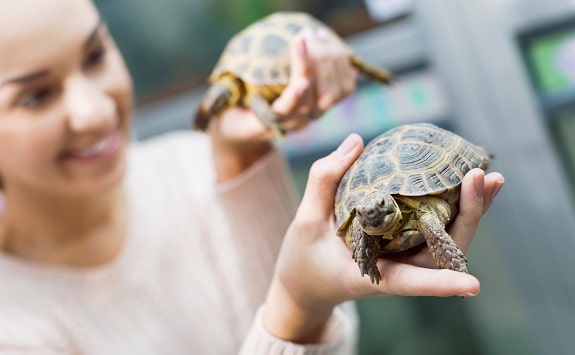
When it comes to temperament, Russian tortoises are an easy-going reptile. They’re non-aggressive and develop strong bonds with their owners.
However, they are not the most cuddly of pets and prefer to interact from the stability of the ground. They will tolerate handling if necessary for transportation, and generally will not bite when picked up.
If you bring your tortoise fresh-picked dandelions, you will soon see how quickly these tiny creatures can move when motivated. Plus the gesture will go a long way toward building your relationship.
Russian tortoises can live alone, in pairs, or in small groups. You might witness some slight aggression between males, since they can get territorial and fight, leading to tip-overs and injuries.
Do NOT house your Russian tortoise with any other tortoise species or other pets. Also, keep a close eye out for any signs of aggression OR fighting between your tortoises when confined to the same pen.
🔑 Russian Tortoise Handling & Bonding Key Takeaways: With the ability to develop strong bonds with their owners and a generally gentle disposition, Russian tortoises make wonderful first time reptiles for people of all ages. Although they’ll never be cuddly or big fans of being held, you’d be surprised how happy a Russian tortoise can be to see its owner, especially if they have a treat in hand!
Is a Russian Tortoise Right for You?
After learning all about this delightful reptile, we wouldn’t blame you for rushing out to purchase an adorable tiny Russian tortoise!
With their gentle demeanors, relatively simple upkeep, and no need for messy live-prey meals, Russian tortoises make ideal pets for first-time reptile owners or more experienced pros alike.
Be sure to create your tortoise’s perfect habitat first before purchasing your new pet, so it will be move-in ready after finding your new companion.
Consider planting grasses and plants for a fresh, pesticide-free food source as well before bringing home your tortoise.
With plenty of tasty bribes, you’ll soon have a friendly, active tortoise that will delight you for hours with their climbing and burrowing antics.
Here’s to many years of enjoying your new best friend!
